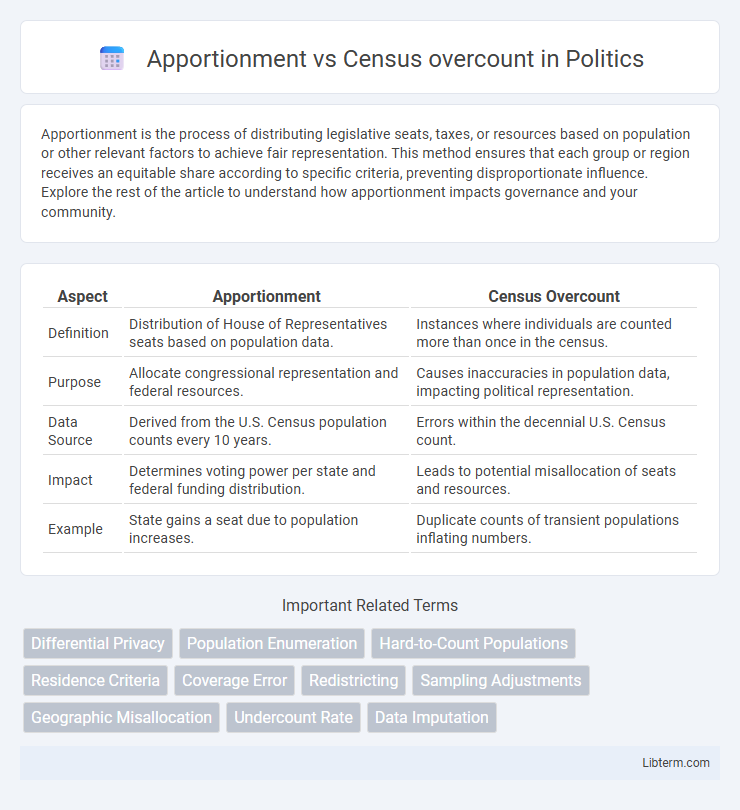Apportionment is the process of distributing legislative seats, taxes, or resources based on population or other relevant factors to achieve fair representation. This method ensures that each group or region receives an equitable share according to specific criteria, preventing disproportionate influence. Explore the rest of the article to understand how apportionment impacts governance and your community.
Table of Comparison
| Aspect | Apportionment | Census Overcount |
|---|---|---|
| Definition | Distribution of House of Representatives seats based on population data. | Instances where individuals are counted more than once in the census. |
| Purpose | Allocate congressional representation and federal resources. | Causes inaccuracies in population data, impacting political representation. |
| Data Source | Derived from the U.S. Census population counts every 10 years. | Errors within the decennial U.S. Census count. |
| Impact | Determines voting power per state and federal funding distribution. | Leads to potential misallocation of seats and resources. |
| Example | State gains a seat due to population increases. | Duplicate counts of transient populations inflating numbers. |
Introduction to Apportionment and Census Overcount
Apportionment is the process of distributing seats in the U.S. House of Representatives based on population data collected during the decennial census. Census overcount occurs when individuals are counted more than once or included erroneously, leading to inflated population figures. Accurate apportionment relies on minimizing census overcounts to ensure fair political representation and allocation of federal funds.
Definitions: Apportionment vs Census Overcount
Apportionment is the process by which the total population count from the census is used to allocate seats in the House of Representatives among the states. Census overcount refers to the instance when individuals are counted more than once or are erroneously included in the population totals, leading to inflated population figures. Understanding the distinction highlights how apportionment depends on accurate census data, while census overcount represents a data quality issue affecting representation fairness.
Historical Context of Apportionment
The historical context of apportionment in the United States dates back to the Constitution, which mandates population-based allocation of congressional seats every ten years. Apportionment relies heavily on census data, but challenges such as census overcount--where individuals are counted more than once--can distort political representation and federal funding distribution. Efforts to address these discrepancies have evolved over time, including statistical adjustments and legal disputes, highlighting the ongoing tension between accurate population counts and fair legislative apportionment.
Causes of Census Overcount
Census overcount primarily arises from duplicate responses when individuals are counted more than once, often due to multiple residences or data processing errors. Mobility and seasonal migration contribute to overcounts as people may be recorded in both their temporary and permanent addresses. Furthermore, data collection challenges such as enumerator misclassification and response bias can inflate population figures, impacting apportionment accuracy.
Impact of Census Overcount on Apportionment
Census overcount directly affects apportionment by inflating population totals used to allocate seats in the House of Representatives, resulting in some states receiving more representation than warranted. This misallocation skews political power and federal funding distribution, as apportionment relies heavily on accurate population counts to ensure equitable representation. Correcting census overcounts is crucial to maintaining fair apportionment, which impacts legislative influence and resource allocation nationwide.
Legal and Policy Implications
Apportionment relies on accurate census counts as these numbers directly determine congressional representation and federal funding allocation, making census overcounts a critical legal concern. Overcounts can lead to misallocation of political power and resources, potentially triggering lawsuits challenging the fairness and constitutionality of the census methodology. Policy implications include calls for stricter census data verification processes and reforms aimed at minimizing enumeration errors to uphold equal representation mandates under the U.S. Constitution.
Methods to Detect and Reduce Census Overcount
Methods to detect and reduce census overcount primarily involve demographic analysis, dual-system estimation, and post-enumeration surveys to identify discrepancies between reported and actual population counts. Apportionment processes rely on accurate census data, making these methods critical for ensuring fair representation by correcting overcounts or undercounts through statistical adjustments. Enhanced geographic analysis and data integration techniques further improve the identification of overcounted populations, supporting more precise allocation of congressional seats.
Effects on Congressional Representation
Apportionment relies heavily on accurate census data to allocate congressional seats among states, but census overcount can distort this process by inflating population figures in certain areas. Such overcounts lead to disproportionate representation, granting some states more congressional seats and federal funding than warranted by their actual population. This imbalance affects legislative influence and resource distribution, skewing political power away from states with accurate or undercounted populations.
Demographic Groups Most Affected
Demographic groups most affected by apportionment and census overcount include racial minorities, children, and urban populations, often experiencing undercounts that skew political representation and federal funding distribution. African American, Hispanic, and Native American communities face higher undercount rates, impacting congressional seat allocation and resource allocation at state and local levels. Accurate census data is critical for equitable apportionment, ensuring fair representation and funding aligned with actual population demographics.
Future Challenges and Solutions
Apportionment faces future challenges due to census overcount inaccuracies that can distort population representation in legislative districts, affecting federal funding allocation and political power balance. Implementing advanced data integration methods and machine learning algorithms can improve accuracy in detecting and correcting overcounts, while enhanced community outreach programs aim to minimize enumeration errors. Leveraging geospatial technologies and real-time data verification tools offers scalable solutions to address evolving demographic complexities and ensure fair apportionment outcomes.
Apportionment Infographic

 libterm.com
libterm.com